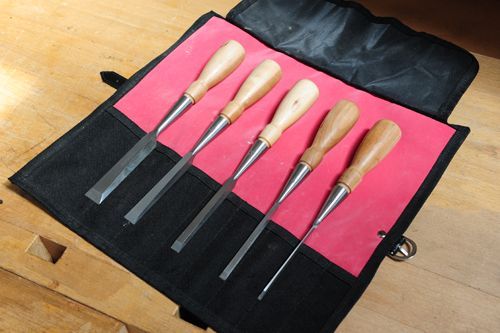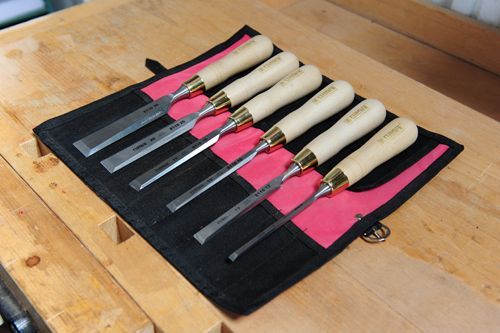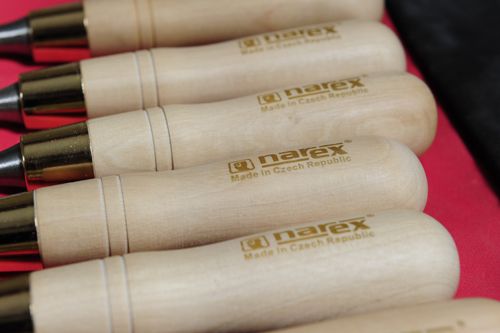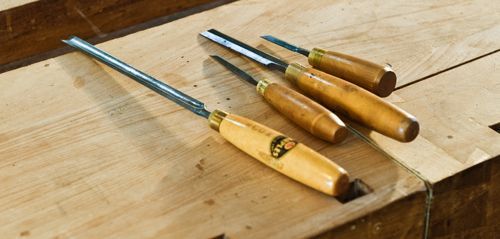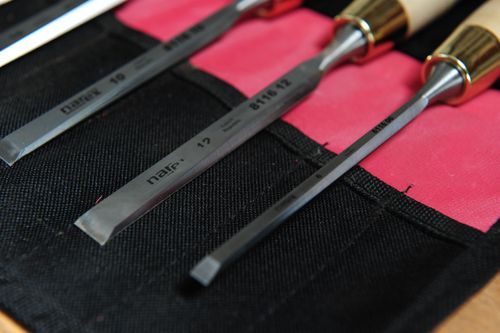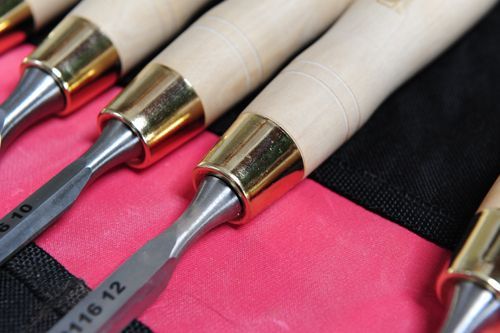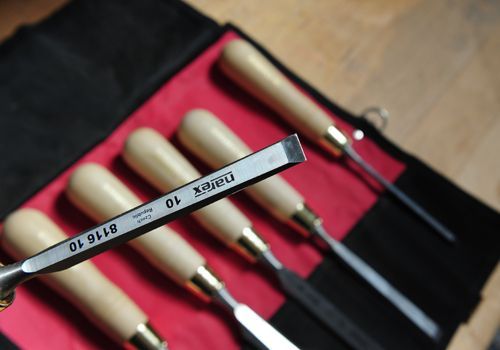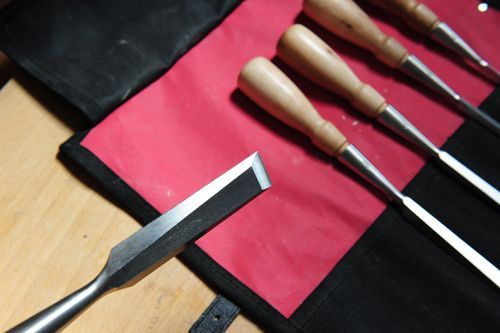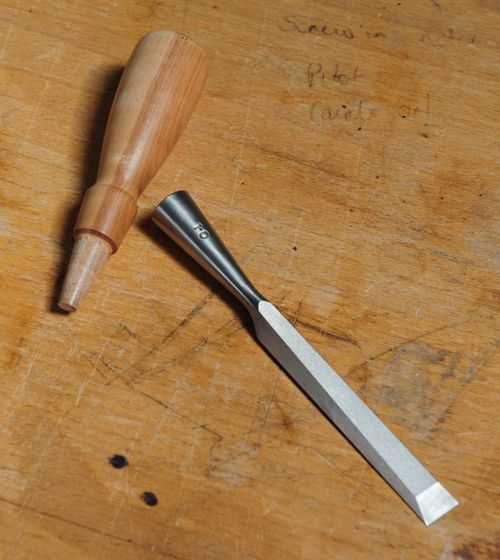CARBON STEEL
I Know! I Know! when it comes to tools I become a reactionary, disgruntled, old fart, a description for which I, regrettably, can not apologise. When I am asked to review modern woodworking handtools I usually ask the manufacturer “Do you really want me to do this, I may not be the best person for the job.” I do this because I have seen, in forty years of woodworking, a great improvement in the quality of hand tools, and I don’t want to discourage these new ideas with my incessant and unreasonable demands for better and better tools.
Planes are flatter, steels have greater age holding capacity and manufacturers are technically more capable of delivering the quality that we require. BUT, and it is a big BUT, the quality of the steel that we are using now is not as good as the steel that I see day after day on the bench in front of me.
I was lucky, I know that, I got in at the very tail end of Sheffield steel making. The blade in my plane is hammered handmade forged steel, my chisels are a mixture of Marples narrow neck chisels and Japanese laminated blades. It is with this old “crucible steel” that I compare any modern toolmakers offering.
We see a lot of tools being bought here at Rowden Workshops; a dozen students each spending up to £2000 on a set of hand tools, that’s a lot of hardware! So it was with great pleasure we received, from Tom Lie Nielsen, a set of carbon steel blades. I have been pestering and pestering the poor man to do this for ages. I find A2 steel, which he uses and is used by many chisel makers, to be a backward step and one I would not encourage in this workshop.
The trouble with A2 is that it holds an edge for a very very long time, so making it very attractive to the amateur. This is the amateur who doesn’t really know how to sharpen blades (see our great DVD – How to sharpen woodworking hand tools) and will put it off for a very long time. The problem is that the edge that A2 steel holds is not a very keen edge, not an edge that I would call SHARP!!!!! It’s a great steel for the manufacturer; it responds well to CNC grinding and processing but the edge is just not THAT sharp; it’s okay for heavy malleting, where the strength of the edge is important but not so good for delicate paring.
So I was delighted to see this set of Lie Nielsen carbon steel blades. Carbon steel or O1 grade is the modern cold roll steel. It comes in many different forms with different degrees of hardness and resistance to wear, but it is “Cold Rolled”. Bear those words in mind when you conjure an image of old fashioned crucible steel worked hot with a hammer. Lots of banging, hot steel red from the furnace and sparks flying. Ayye Lad That’s Sheffield. Or, it was…
Managing director of Clifton Tools Alan Reid, many years ago, took me around the deserted industrial landscape of Sheffield and showed me museums, the old workshops of “the little masters” and the decaying industrial landscape. He spoke with a passion and eloquence about the lost skills and a lost knowledge of steel. A loss that was being suffered almost without a backward glance.
He also spoke about steel and the steel that I knew about. He described how that keen edge was created, ” It’s like carbon steel has a structure made up of long grain rice. When that steel is hammered and heated those long grains that were crossing each other and leaving gaps between each other suddenly start to come into alignment and fit closely together. This gives you a fineness of steel structure right at the cutting edge. This is that cutting edge you are using”. This is the forged steel, or ‘crucible’ steel, that I keep going back to. This is the steel I want to see being used in this workshop. This is the steel that tool manufacturers should be giving us but probably never will again.
This is available, however, sometimes in the best of Japanese chisels. Here a modern cold rolled steel is heated and laminated to a soft steel backing. In the best, but not all manufacturers, the process of creating this “forge welding”, this hot steel laminating, is, I believe, changing the steel structure of the hard cold rolled steels being laminated together. In the hammering and heating it is improving the steel structure in the way that Ian Reid described.
However… during the latter part of the 20th century many of the very small workshops that produced my Japanese blades did not survive; they were small craftsmen toolmakers often with only a small output. The larger factories that now make most of the Japanese chisels we see here in the West do not seem to produce steel of the same “Crucible” quality.
To give Tom’s carbon steel Lie Nielsen chisels a run for their money I asked Malcolm at Workshop Heaven to send me examples of the Narex chisels that he imports from Czechoslovakia. Malcolm is unusual in tool sellers in that he does have some understanding of how the tools might be used. This is useful.
On immediate comparison the Narex looked less expensive, and indeed they are. I only have the pricing of the A2 Lie Nielson blades to hand so I apologise that I cannot be accurate. They are nearly FOUR TIMES MORE EXPENSIVE than the Narex blades. So, leaving that small matter aside what do we have?
Narex are exceptionally well-made chisels the grinding is excellent, really excellent. The quality of steel I would pull alongside everything that is currently made today including Sorby, Ashley Isles, and Lie Nielsen maybe it’s even a bit better, it is hard to tell. The engineering, the metal bashing is really excellent, what lets this great product down is superficial appearance.
Students perhaps understandably go for good looks, they want a set of chisels that portray their intentions ” I am going to be a cabinetmaker”. To do that I need nice shiny boxwood handled……. It’s not that the Narex Hornbeam handles are particularly unpleasant. They are nicely made, but when you compare them to the Hornbeam on the Lie Nielsens’, it doesn’t look like the same timber. Narex handles seem like they are less well finished. For the addition of a little bit more polish they would, I believe, justify a modest price increase and probably develop sales.
Narex proclaim that they offer different handles for different sizes of chisel. Yet the 5 most commonly used sizes, which I have seen, all have the same size handle. Look at the photo I have included here of my own bench chisels.
My tiny 1/8th inch blade has a tiny handle to go with it, a larger half inch blade has a longer heavier handle to counterbalance the longer heavier blade. Than you have on the right a 3/8 blade which in the past was much longer, as it got shorter I would cut the handle back to keep the balance. The balance is absolutely imperative. Lazy uninformed toolmakers have got to take note and got to handle their chisels in a proper and appropriate manner.
While you’re doing that Mr Narex get rid of the cheap and nasty brand printing both on the blade and on the handle.
Lie Nielsen will show you the way to go; a discrete logo stamped in the steel. Finally can you ditch that rubbish mock brass ferrel?
All it does is signal to us the idea that we are buying something that is NOT the same the whole way through. This is a tool that is shiny only on the surface.
I do not wish to be unkind. These Narex blades are, to my mind, exceptionally good value and I will be recommending them to students here.
However I bet that I won’t be able to sell them even at a quarter of the price of their competitors because of these minor silly imperfections.
Okay Tom pin back yer lug ‘oles, its your turn for “the hairdryer treatment”. You more than anybody else have enabled woodworking hand tool makers to come into the 21st century with a degree of integrity. Your products have moved against the trend of downgrading and ‘deskilling’. Without you we would all still be flattening every plane that came in to the workshop, spending hours faffing around with plates of glass and abrasive. You’ve taken engineering experience and applied it to contemporary woodworking hand tools and done a damn good job. Thank you.
You have, however, relied upon old designs; taking what you thought was the best to copy in modern methods and materials; The Stanley 750 that you base your design upon was a great tool. An everyday woodworking blade, it could be malleted to death and the strength of blade, the socket handle design, and the Hornbeam, all resisted that really well. The A2 steel played its part in this. Ground to 30° and honed to a tad under 35 you could smack this mother around all the day long. I’ve seen students with a set of your A2 blades forget all about sharpening, they just carry on for weeks or months at a time. Which is another problem.
Your carbon steel blades however are different, they take what I will call “a proper edge”. Sure they have to be ground to an angle of the 25° and honed to an angle not more than 30.° That is an edge that you can push. A delicate paring edge, not a malletting edge. This is what this is all about, A2 is good for heavy work. But furniture makers like me don’t just batter away. We are delicate souls that sometimes just push and pare. Please give us a blade that responds to that sensibility. The design of your tool is heavy, beautifully made, dead flat (well done Tom, you are absolutely alone in giving us flat and I love you for it). But its too heavy, way too heavy, using it is like asking an F1 racing driver to get in a tank and go fast when he has just stepped out of a Ferrari.
Despite being carbon steel both brands will take a deal of hammering. I chopped the Lie Nielsen and Narex blades into hard maple time after time removing 50 mm of 10mm by 30mm stock before examining the edges with a jewellery loupe, and comparing. Both brands compared remarkably well to each other which is a great result for Narex and a great result for Lie Nielsen, I think.
-DBS-
(First publication date: May 2012)
PS…
Thomas Lie Nielsen’s response to the article
Nick,
Thank you for sending this. I have some comments that may be helpful to all of us. Please share them with David and give him my kind regards.
If David wants to review any of my tools, I’d be happy to have him do so. The first paragraph makes it seem like he contacted me, and he didn’t. No matter.
5th paragraph: This is a common debate on this side of the pond, and many claim A-2 will give them as sharp an edge as O-1. I tend to agree with David. We don’t use it because it is easy for manufacturing, however. It is not.
David is absolutely correct about the shameful demise of the Sheffield steel making industry. I really like his description of what Alan showed him. If I could get my hands on some of those old fellows who used to work in the forges there….
Because, it is not really the quality of the raw material, the steel, that is the problem. The problem is that forging is becoming a lost art. Narex still forges. I’ve been looking all over the US for a source for forgings. No luck.
I am not at all pleased that my chisels cost almost four times the Narex chisels in the UK. They are $55. in the US. Still expensive, but not so bad. Part of the reason is duties, freight and dealer mark ups. Part is that it is expensive to make tools in the US in the 21st century. I’m not moving to China, so I just have to accept that part.
The sample Narex chisels that I have sitting on my desk do not have what I would call excellent grinding. But they are not bad.
I agree that the design of the 750s is heavy. I have one well known furniture maker here in the US, Chris Becksvoort, who wants them heavier! I’m not going to make them heavier. I like their balance the way they are.
However, we offer the O-1 because we’ve been asked for it by customers who prefer that steel. Obviously, they are not paring chisels, and it is my desire to make a lovely, thin and delicate paring chisel soon.
When I do, I’d like to hear what David thinks!
Best,
Thomas
PPS
Another response – this time from Matthew Platt of Workshop heaven
Hi Nick,
Wouldn’t he have made a wonderful captain of a Napoleonic ship?
On technical points there are a few discrepancies, all of the English and Czech chisels are hot forged complete with fire and sparks, LN A2’s are CNC’d from a block so I’m not sure if they are doing the same with O1 (bloody expensive way of going about it if they are).
The suggestion that the steel making industry has evolved backwards with 100 years of innovation and investment is intriguing. All steel is now made in a crucible and cast, which is why they dropped the words cast and crucible, it’s not like anyone is baking bars of pig iron in charcoal for a week at a time any more so there is nothing for cast crucible steel to be different from.
Cold rolling is used for making thin sheets of steel (cars, washing machines, crap circular sawblades etc) you wouldn’t use it to make a lumpy thing like a chisel.
Having said that, publishing David Savage is like drinking pints of tequila, you either do it wholeheartedly and face the consequences or you don’t. I’m sure anyone who feels unhappy about it knows that you will publish their measured response too.
I think the fairest thing would be to forward this on to David and give him the opportunity to make any alterations if he wishes to.
Cheers,
Matthew
…and my response to that…
The distinction that I draw by calling it “cold rolled”, a term that was given to me by a sheffield tool maker, is that modern tool steels are not being hammered as it’s too expensive. Tom sees this and agrees it’s what he calls “forging skills” and they are being lost. What Matthew is not saying is that Narex properly FORGE their blades. They do NOT bang and hammer them to change the steel structure as Alan Reid described. Or, if they did we would have better blades than we have. Sure they may heat and pour but that’s not the same.
Publish and be damned.
David
